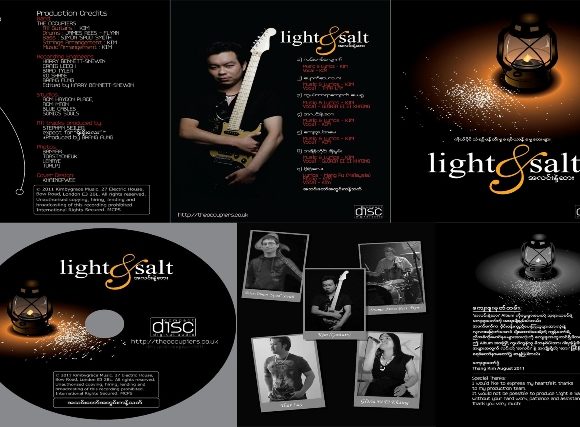An Interview With Dai-Chin Pastor Shwekey Hoipang
30 August, 2008- London, UK [CG Note: He belongs to one of the Chin tribes called Dai. The Dai Chins live mostly in the Southern Chin State of Burma. Shwekey Hoipang, a pastor and evangelist, is currently studying Master of Theology in Wales, UK.
He has recently returned from a trip to Malaysia where hundreds of the Dai people live as unrecognised refugees. In this interview, Shwekey Hoipang talked to Van Biak Thang of Chinland Guardian about the Dai people, Dai women’s facial tattoos, the situation of Chin refugees in Malaysia and more …]

Chinland Guardian: Frankly speaking, the Chin people know very little about each other due to enormous difficulties in communication among themselves. What can you tell us about the Dai-Chin?
Shwekey Hoipang: The Dai-Chin is one of the 32 Chin tribes, which have been registered by the Government of Burma since 1890. The recent Military Regime’s census mentions the Dai tribe as the 62nd of 135 tribes of Burma. Researchers sometimes refer to us as Dai or Yindu in the ethnic survey book of Burma. The word Yindu, meaning from chest to knee, derives from our Dai dress code, the length of which stretches from chest to knee. The origin of Dai-Chin appears to be from Mongoloid stock, Indo-Chinese descent, and Tibeto-Burman family as the other Chin tribes do. Researchers and historians often confuse the name Dai with Tai. There are 52 ethnic groups in China and one of them is Tai (sometimes written as Dai). Their home is Yunnan province. The Dai-Chin and the Tai-Shan are two different people groups. The Dai people live in Mindat, Paletwa, Matupi and Kanpetlet townships of the Southern Chin State, Burma. There are 175 Dai villages with a total population of somewhere between 60000 and 90000. The population makes the Dai-Chin as the majority tribe in the Southern Chin Hills.
Chinland Guardian: What distinct features do you think make the Dai-Chin different from other Chins especially in the North?
Shwekey Hoipang: I think the appearances of body shape and skin colours of the Dai-Chin are similar to other Chin-tribes. But the Dai women’s facial tattoo is a very unique feature. The Dai women must be tattooed when they reach adolescence so that they will be able to enter adulthood. Without a tattooed face, a Dai woman is thought to be abnormal. The Dai-Chin practices animism as their traditional religion. The Dais are self-sufficient, independent and loving people. However, retaliation was the principle of the Dai court or justice system. Eye for eye, tooth for tooth, and life for life is the fundamental principle of the Dai society. In 1970s, Christianity was introduced into the Dailand and as a result of the Christianity, the Dai society was transformed into the modern civilisation.
Chinland Guardian: Tell us more about the facial tattoos in Matu and Paletwa areas.
Shwekey Hoipang: Originally there are three tribes in the Southern Chin Hills (Dai, Matu and Mün), and all practice facial tattoos for the female but with different styles. The Dai tattoo is green-blue or navy-blue colour on the whole face with many small spots. The Matu tattoo is black colour on the cheek and forehead with some three to five straight lines downwards. The Mün tattoo is big circles on the face and neck. The Dai people are living in all four townships of Southern Chin State; they all share the same facial tattoo styles.
The origin of the tattoo is a myth in history but the oral history says: once upon a time, the Dai girls were always more beautiful than any other neighbouring tribes. One Burmese King saw a beautiful young Dai girl and asked her parents for permission to marry and then married her. However, the Dai leaders did not want the Dai girl to marry the Burmese King or any other outsiders. The Dai leaders decided to introduce facial tattoos to protect the Dai girls and prevent them from marrying outsiders. I am not sure if this is the true origin of the facial tattoos.
Chinland Guardian: Has the Dai-Chin got any version of Holy Bible translated into Dai dialect?
Shwekey Hoipang: Yes, the Dai people have got New Testament of the Bible, which was published in 1995 by United Bible Society. The translators are Mr. Näng Küi (Pastor, Brethren Church) and Rev. Mnai Näng (Minister of the Methodist Church) and supervised by Mrs Helga Hartmann-So (the wife of the first University graduated Dai-man Mr. Cheng So, who died in 1996 with a brain tumour). Unfortunately, the Dai NT is not useable and not popular amongst the Dai people.
Chinland Guardian: Recently, Chin people in Southern Chin State face various problems including food shortage. Military authorities hunt down and arrest people who opposed the referendum. And also, there were religious persecutions going on in the areas. Can you tell us more about these ‘military’ acts of atrocities?
Shwekey Hoipang: Yes, there are so many difficulties in the Southern Chin Hills just as there are in the Northern Chin Hills. The major famine was caused by Bamboo-Flowering (in Dai language, Mtam). The bamboo-flowering produced bamboo-fruiting and as a consequence, the rat population increased dramatically. The rats ate all the crops and caused the famine for the Southern Chin people, especially in the bamboo forest areas, the home of the Dai people. On top of that, because of ongoing forced labour by the military regime, the young people are fleeing on a daily basis and entering Malaysia as refugees.
The Dai received the gospel in the 1970s and by now 98% profess to be Christian if not all 100% as Christian. The military junta persecutes the Christians in Dailand by not allowing them to perform Christian activities such as Christmas and conferences and also not allowing the building of new churches in Dailand. The majority of Dai people voted “NO” for the Constitutional Referendum and arrests are going on.
Chinland Guardian: You were known to be actively involved in political activities in late 1980s, and hunted by the military authorities. What had you done and happened to you then?
Shwekey Hoipang: I was actively involved in the 1988 Students Demonstration in Sittway (Akyab) whilst I was an itinerant evangelist. I was then an organiser (Si-yung-yay-hmu) of Chin National League for Democracy (CNLD) in Paletwa Constituency. The CNLD Secretary General Dr. Lian Hmung Sakhong came to Paletwa and requested me to join the CNLD. I then became an organiser of Membership Recruitment of the CNLD. I accepted his request quickly and was actively speaking about CNLD policies in several Chin villages in Paletwa Township. In Paletwa constituency, the CNLD Chairman was a Dai-man, Mr. Sein Tha Aung (Mr. Khäng Phäi from Pängdä village in Paletwa Township) and a Khumi-man Mr. Ting Tuk, a lawyer and Secretary General of CNLD in Paletwa.
There was a general election in Burma in 1989, and the CNLD won three parliamentary seats in the Chin State. However, Burma’s military regime annulled the election results and arrested all the elected CNLD MPs and Party leaders. As a consequence of this, I was arrested on three separate occasions in 1989 and 1990s. I am still on their hunted name lists. When I was a Christian missionary for some periods in Rakhine State, I faced all sorts of difficulties such as not being allowed to build church buildings, limiting travelling areas, and requiring me to report all of my activities to the local authorities of the military regime. My passport application was delayed for three years (1999-2002) because of my past involvement in politics and my present activities as a missionary in the Buddhist stronghold area in Rakhine State.
Chinland Guardian: We have learned that you made a fact-finding trip to Malaysia regarding Chin refugees. What can you share with us about it?
Shwekey Hoipang: As I had mentioned in my previous conversation, there are 962 Dai refugees whilst there are at least 8,000 other Chin refugees in Malaysia. I visited Kuala Lumpur, Malaysia to encourage the Dai refugees both spiritually and physically. I arrived in KL on the 7th of February and left for London, UK on the 13th of February 2008. It was a good time to be with my tribesmen although I had mixed feelings, joy and sorrow.
I paid visits to both Chin Refugee Centre (CRC) and Alliance Chin Refugees (ACR). I was surprised to see John Khua Bawi because he was one of my friends when I was in my high school days at State High School No. 1 in Mindat. Although he was from Matupi, he studied in Mindat. He serves as a Chairman of ACR in KL. I had a good exchange with him. I also met with CRC leaders and had a productive conversation with them as well. I had a privilege to meet and speak with Victor Khen Sang from Canada at CRC office in KL whilst he paid a visit to help Chin Refugees over there. We had a good conversation on the issue of Human Rights abuses in Chinland.
Chinland Guardian: Based upon the recent situation of Chin refugees you saw in Malaysia, what do you think could be done for their betterment both by Chin communities and international organisations?
Shwekey Hoipang: Sadly, the Chin Refugees are facing fears every day because the Malaysian police and immigration hunt them down everywhere. There are many Chin refugees in Malaysian prisons. I was able to speak with the UNHCR official in Malaysia for the Dai refugees. Some of the Dai refugees are in prison and most of the Dais do not get UNHCR registration. As a result of my visit, one of the Dai prisoners was released with the help of UNHCR. I am now helping Dai refugees to get a new UNHCR registration. I also have learned that there are at least 17 Chin Christian Churches in KL alone, which makes me full of joy. I believe that we, the Chin people, are “The Apples of God’s Eyes”. I think we should be working together in Unity – ‘Hands, Hearts, Heads Together’.
I have learned that Ben Rogers of Christian Solidarity Worldwide, UK also visited the Chin refugees in KL whilst I was in KL. I met Ben Rogers at a “Prayer Day of Burma” programme in London on the 8th of March 2008. I have watched a report of his trip to KL as well. I think the world leaders should recognise and help the Chin refugees in Malaysia, India and Thailand immediately.
Chinland Guardian: We have heard that your church in Yangon has been hit by Nargis cyclone and the building itself was completely destroyed. Have you got any kind of aid/help from the Burmese government? And how are they getting on now?
Shwekey Hoipang: Yes, my church in Yangon and Bathein were both hit by the deadly Nargis Cyclone but the military regime helps with nothing. Here in the UK, some of my friends’ churches sent financial help to my church and the most affected areas. One of my former co-workers led the youth group from my church in Yangon and they have taken rice packs, clean water, and clothes to Nyaungkung village, Dedaye Township in Irrawaddy delta. They gave me a report saying that the village has about 2,000 population before the natural disaster but by now there are only 1200 people with no shelter and food. Rotting corpses and animal bodies still remain in the area. No one has buried them. They shared the contributions they had. After that, they returned to Yangon in the evening. On their way back, the military junta blocked the road and checked all the donor-cars and made some arrests but by the grace of God, my church members escaped from the arrests. The military regime has not allowed helping the disaster victims.





